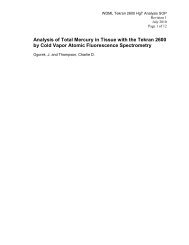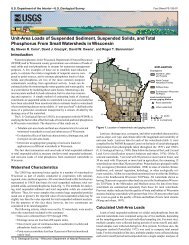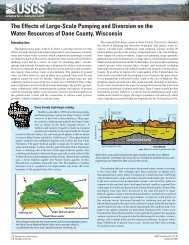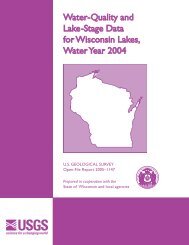Nippon MA-2 Mercury Analyzer - Wisconsin
Nippon MA-2 Mercury Analyzer - Wisconsin
Nippon MA-2 Mercury Analyzer - Wisconsin
You also want an ePaper? Increase the reach of your titles
YUMPU automatically turns print PDFs into web optimized ePapers that Google loves.
Principle of Operation<br />
Solid sample is combusted at high temperature (850 C) in the presence of<br />
interference-reducing reagents, releasing mercury from the matrix as reduced<br />
gaseous mercury. In the resulting gas, matrix interference is further eliminated<br />
by catalytic treatment, adjusted to appropriate pH in a phosphate buffer, and then<br />
passed through a gold amalgam trap to quantitatively capture gaseous mercury.<br />
Lastly, the gold trap is heated, releasing the bound mercury into the sample<br />
stream, and detected by cold vapor atomic adsorption. A more detailed<br />
description of the principle of operation is available in chapter two of the<br />
manufacturer’s instruction manual.<br />
Safety Concerns<br />
Multiple safety concerns are present in the operation of this instrument. Although<br />
mercury is a dangerous neurotoxic metal, concentrations encountered in the<br />
samples and standards generally measured on this instrument are relatively low.<br />
However, caution should still be exercised to limit chronic mercury exposure.<br />
Extremely high temperatures are used to heat the catalyst, ceramic combustion<br />
boats, and reagents prior to use. These will remain hot minutes (boats) to hours<br />
(reagents and instrument) after heating; use caution in handling these items.<br />
The automated sample loader and tray start moving without warning during<br />
analysis and are a mechanical hazard. Finally, the powdered analytical reagents<br />
are very fine and pose a severe harmful particulate inhalation hazard (see<br />
attached MSDS for further details). Due care must be exercised in handling<br />
these reagents, and should include the use of appropriate precautions<br />
(particulate filter fume hood, appropriate disposal, and regular cleaning of<br />
surfaces with dust vacuum).<br />
Instrument Operation<br />
This document is intended as an additional standard operating procedure (SOP)<br />
designed to guide the user through mercury analysis specific to the <strong>Wisconsin</strong><br />
District <strong>Mercury</strong> Laboratory. A condensed version is also provided following the<br />
detailed SOP, and is intended as a quick reference bench guide for the analyst.<br />
However, the analyst is required to be familiar with the detailed SOP as well as<br />
the original user’s manual provided by <strong>Nippon</strong> which will be referred to when<br />
appropriate.<br />
Start up<br />
If the instrument is off, turn it on with the switch near the mains. If necessary,<br />
start the software (click on shortcut located on the desktop, “<strong>MA</strong>2000”) and open<br />
the appropriate (HIGH CAL or LOW CAL) template file. The template files<br />
include a standard curve that was successfully used on the instrument for the<br />
previous analysis; it is not necessary to calibrate the instrument with every use.








